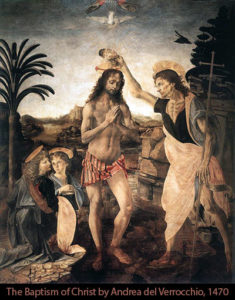John appeared, baptizing in the wilderness and proclaiming a baptism of repentance for the forgiveness of sins. And all the country of Judea and all Jerusalem were going out to him and were being baptized by him in the river Jordan, confessing their sins. Now John was clothed with camel’s hair and wore a leather belt around his waist and ate locusts and wild honey. And he preached, saying, “After me comes he who is mightier than I, the strap of whose sandals I am not worthy to stoop down and untie. I have baptized you with water, but he will baptize you with the Holy Spirit.”
In those days Jesus came from Nazareth of Galilee and was baptized by John in the Jordan. And when he came up out of the water, immediately he saw the heavens being torn open and the Spirit descending on him like a dove. And a voice came from heaven, “You are my beloved Son; with you I am well pleased.” – Mark 1:4-11
The passage above is the gospel reading for the Sunday after the Epiphany. Epiphany is the manifestation of God incarnate in Jesus, particularly to the Gentiles as represented by the “three kings” (the Magi) in their visit from the east. There can be some confusion here because, although the Epiphany is the first day after the 12 days of Christmas, the wise men visited a couple of years after Jesus’ birth. We know this because of their interaction with Herod and his command to massacre the boys 2 years of age and younger. The gospel account says that the holy family was in a “house,” meaning that they were no longer in the manger. Still, it is a valuable period on the church calendar to help us engage with the rhythm of the history of redemption.
Very close to Epiphany is the Baptism of Jesus, which is celebrated on the first Sunday after Christmas. That’s why the gospel text above was chosen. Depending on how the dates and Sundays fall from year to year, the concentration may be on the one or the other. This year it is the baptism of Jesus, along with a reading from Acts 19, which is another place where the Spirit descends (as at Jesus’ baptism).
There are just a few verses here, but so much is taking place! Looking at some of these same verses during Advent, we saw that John the Baptizer is the new Elijah. Not only does he dress like Elijah, but God’s similar action at the Jordan River is impressive. Elijah and Elisha cross the Jordan on dry ground and that’s when Elijah asks Elisha what he can do for him. Elisha asks for a “double portion” of Elijah’s spirit. So there, on the western side of the Jordan, Elisha receives his request as Elijah ascends to heaven, and his “mantle” falls and strikes the Jordan, dividing the waters. Elisha crosses over to Jericho and heals the city’s cursed water.
Moses also ascended on the west side of the Jordan (“opposite Jericho,” Deut. 34:1). Joshua was his successor who also received the Spirit to continue God’s work. Joshua crossed the Jordan on dry ground and went to Jericho to wage war and to destroy it.
This demonstrates that John the Baptizer is the new Moses, and Jesus is the new (and better!) Joshua; John is the new Elijah, and Jesus is the new (and better!) Elisha. These instances show a passing through the waters of the Jordan into places away from the Promised Land where the battle can be fought. John baptizes Jesus who receives the Spirit and goes away to the wilderness to wage war against principalities and powers in high places, the spiritual forces of wickedness, and wins!
If we think for a minute about Jesus’ baptism, even more remarkable things are revealed. Mark says that Jesus “saw the heavens being torn open and the Spirit descending on him like a dove.” We’re used to hearing the Spirit described in such terms, but that would have been a real shocker to the original audience. The only place the Spirit of God was likened to a dove was in the Targum. That’s the Aramaic version of the Law and Prophets. Hebrew was used more for study, so the Targum was in the everyday language of Jesus’ time. The creation account of Genesis 1:2 says “the Spirit of God was hovering over the face of the waters, and God said, ‘Let there be light.’ “ The word translated in the ESV, “hovering,” also means “fluttering.” To capture the image, the rabbis who compiled the Targum said, “And the Spirit of God fluttered above the face of the waters like a dove, and God said: ‘Let there be light.’ “
Here we have the same three parties present at Jesus’ baptism as in the creation account: God the Father, God’s Spirit, and God’s Word, through which He creates. Not only that, but the Spirit was over water! In the same way that creation was the work of the Triune God, Mark is saying that the redemption of the world (i.e., the rescue and renewal of all things) has begun with the arrival of King Jesus.
God the Father, God the Son, and God the Holy Spirit, above the waters, speaks: “And a voice came from heaven, ‘You are my beloved Son; with you I am well pleased.’ “
Think of it: Jesus is baptized and He is enveloped with the best thing anyone could ever hear from his father: “I’m delighted with you!” There’s so much more I’d like to say, but let us be clear that the heart of all Christianity is summarized here. When the living God beholds every person baptized into Christ Jesus, He looks at each one and says, “You are my dear child: I’m delighted with you.” And that’s the gospel!
Come hear it preached and enacted in the supper with Jesus this Sunday.
